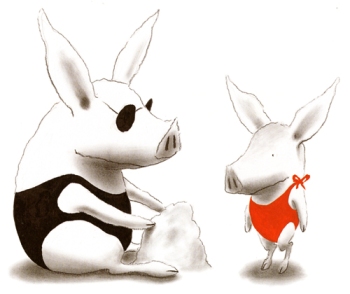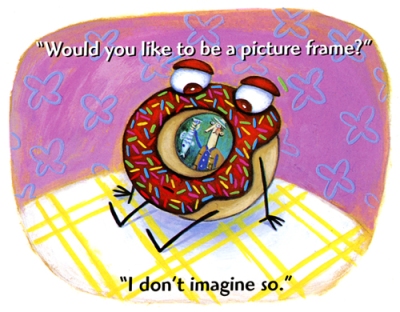 Anthropomorphism is the act of attributing a human form or to a non-human object or being.
Anthropomorphism is the act of attributing a human form or to a non-human object or being.
I have been trying my hand at anthropomorphizing (it is as hard to type as it is to say) but I have yet to be hired to illustrate a book with non-human characters. So far my books have always portrayed children (with a few semi-sentient toys).
A few years ago I created some sample illustrations for “Zoo Shoes,” a charming story by Amy MacDonald.
Amy and I pitched the manuscript and the illustrations around for a while but we failed to find a publisher for the project. Still, it was a good exercise for me to play with anthropomorphization (that’s as hard to type as it is to read), and someday, I hope these two lovelies will have a story of their own.
Anthropomorphism probably goes back as far as storytelling. It is standard practice in mythology and folk tales – Coyote, Raven, Spider, Mother Nature. It must be innate for humans to project human psyches into everything we perceive. Aesop’s Fables, Mother Goose, Br’er Rabbit – these tales allow us to critique human foibles without offending anyone specifically. It’s like seeing someone else’s reflection in your mirror,
which is very useful in storytelling to children.
Perhaps children can see themselves in animal characters more easily than human ones because animals are often small and misunderstood and vulnerable.
Plus animals are cute and kids like cute things (and so do their parents).
Another advantage is that animals can be identified by their characteristics without bias or prejudice. An aardvark with self-esteem issues can then help us learn the value of accepting oneself and one’s nose.
Animals also have no racial identities, so any child looking at a picture book can identify with a little bear,
and animals can be foreigners in Human-Land without having to be identified by their nation state. They are clearly from Animal-Land, and that is enough.
In case you want to take a stab at this approach yourself, the steps to anthropomorphization are simple:
Give upright posture, some cute clothes, a hat.
But most importantly, give whatever non-human subject you’ve chosen the facial and emotional expressions of people.
Pretty much anything can be, and has been, anthropomorphized in picture books.
Are there disadvantages to using anthropomorphism in picture book illustration? Not that I can think of, except perhaps running the risk of making your characters too cute, or worse, too human.
However, let it be known that there are dangers inherent in anthropomorphism itself. We must not expect everything we portray as human to behave accordingly.
Some restraint is wise.






















Love this post, thank you!
I recognize many furry friends, but what is the final image?
It is from Push Kitty, by Jan Wahl, illustrated by Garth Williams. A wonderfully weird little book.
The illustration for Zoo Shoes is lovely. Hope some smart publisher picks it up one day…
Enjoyed these examples. I hope your hippos find a home! My son went through a hippo phase. We checked out every hippo book. There’s always room for one more.
I admire and see the value in this technique for animals however am a little creeped out when commercials anthropomorphize food (esp. stuff they expect us to buy and eat!)
Wonderful post! I love anthropomorphic characters. 🙂